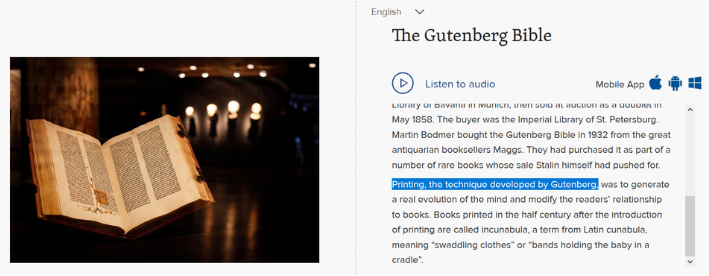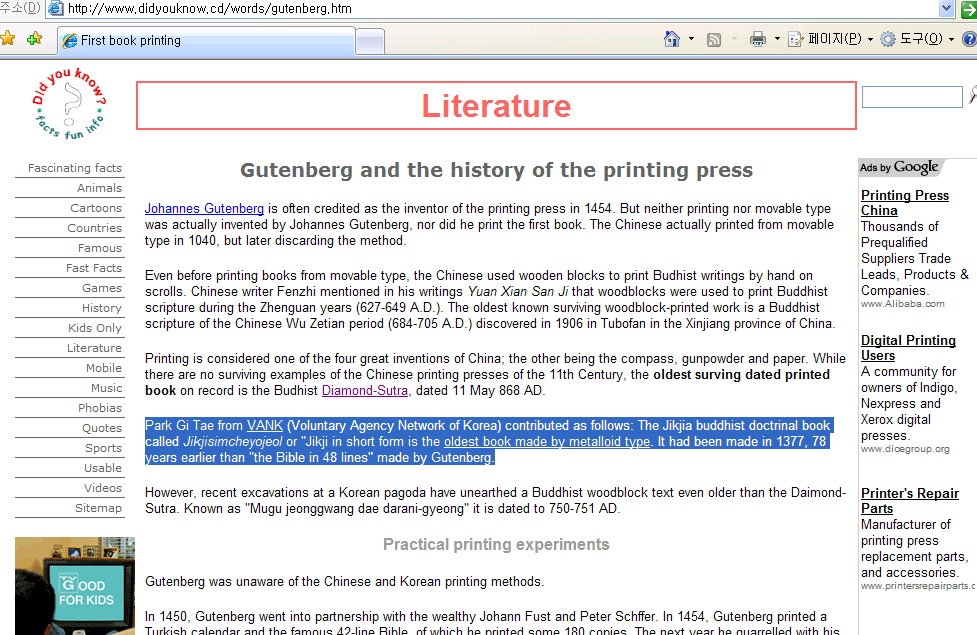VANK is dedicated to promoting Jikji to textbook publishers, encyclopedias, museums, and educational websites in order to educate students and teachers around the world about rich Korean history and culture.
As a result of VANK members’ effort, Jikji was included in the renowned British publisher Dorling Kindersley (DK)’s Timelines of History second edition. It was also included in the famous American publisher National Geographic’s World History, published in 2018. Further, Jikji was added in many other reputable sources, including educational websites, the American Printing History Association website, and museums in France and the United Kingdom.
 Jikji in a Renowned British World History Book
Jikji in a Renowned British World History Book
Dorling Kindersley (DK), a renowned British publisher, included Jikji in its publication of Timelines of History in 2018 at the request of a VANK member. DK publishes textbooks, encyclopedias, and world history books in 62 languages and in 87 countries, including the United States, Canada, Germany, the United Kingdom, China, and India. Jikji is introduced in a section about “the Story of Printing: A Revolution in Human Communication Changes the World Forever” on page 154. The image of Jikji is included with a description that reads “In 1377: The first movable metal type is cast in bronze in Korea and is used to produce the Jikji Simche Yojeol.” The Gutenberg or 42-Line Bible, the first book printed with movable type in Europe, printed in 1455 – 56, is included on the same page.
 Jikji in a famous American World History Textbook
Jikji in a famous American World History Textbook
National Geographic, a famous American publisher, included Jikji in its publication of World History in 2018. Jikji is introduced in a section about Korean Culture on page 268, along with Korea’s national dish, Kimchi.
“In 1377, Korea produced Jikji, the world’s oldest book printed with movable metal type … Korea used metal type 78 years before it was first used in Europe.”
 Jikji on the American Printing History Association Website
Jikji on the American Printing History Association Website
The American Printing History Association included Jikji on the History of Printing Timeline page at the request of a VANK member. The American Printing History Association, established in 1974, is an organization that researches and publishes a scholarly journal on the history of printing and related arts and crafts, including typefounding, typography, bookbinding, papermaking, illustration, and publishing. It also hosts a conference and lecture series about printing and awards individuals who make significant contributions to the field of printing history.
 Jikji on a Renowned British Textbook Publisher Website
Jikji on a Renowned British Textbook Publisher Website
DK, a renowned British textbook publisher, included Jikji on its children education website, DK Find Out (dkfindout.com), at the request of a VANK member. The website describes the Gutenberg Bible as the first book printed with metal type in Europe and Jikji as the first book ever printed and printed in Korea in 1377.
Jikji in French Museum Content
 The Martin Bodmer Museum, operated by the Martin Bodmer Foundation, included Jikji in its museum tour guide at the request of a VANK member. We convinced them to include Jikji in their description of the Gutenberg Bible. As a result, the website added, “a printing press, one century after the invention of the movable metal type use for the Korean Buddhist document Jikji.”
The Martin Bodmer Museum, operated by the Martin Bodmer Foundation, included Jikji in its museum tour guide at the request of a VANK member. We convinced them to include Jikji in their description of the Gutenberg Bible. As a result, the website added, “a printing press, one century after the invention of the movable metal type use for the Korean Buddhist document Jikji.”
Jikji on a Japanese History Education Website
 The Window to World History (www.y-history.net) is a history education website for Japanese high school students, teachers, and the Japanese public. This website included Jikji at the request of a VANK member. Previously, it wrote, “In the early thirteenth century, Goryeo used movable metal type, but no book survived from that period.” We convinced them to include Jikji, the world’s oldest book printed in Korea in 1377, by stressing the importance of accurate information to foster a better understanding of history. Consequently, the website manager informed us about its correction. The updated version includes information about “the world’s oldest movable metal type cast in Korea” and “Korea’s movable metal type,” as well as Jikji, the world’s oldest extant book printed with movable metal type.
The Window to World History (www.y-history.net) is a history education website for Japanese high school students, teachers, and the Japanese public. This website included Jikji at the request of a VANK member. Previously, it wrote, “In the early thirteenth century, Goryeo used movable metal type, but no book survived from that period.” We convinced them to include Jikji, the world’s oldest book printed in Korea in 1377, by stressing the importance of accurate information to foster a better understanding of history. Consequently, the website manager informed us about its correction. The updated version includes information about “the world’s oldest movable metal type cast in Korea” and “Korea’s movable metal type,” as well as Jikji, the world’s oldest extant book printed with movable metal type.
The website describes Jikji in detail, including the year of its printing (1377), preceding the Gutenberg Bible (1455) by 78 years, its discovery, current location, and why it is in France, and its content. At the end of the section, it also specifies that the correction was made at the request of Oh Yujin, a VANK member.
Jikji on an International Printing History Website Prepressure (prepressure.com), an international printing history website, included Jikji at the request of a VANK member. The website includes an image of Jikji with a description that reads “The oldest known book printed using metal type dates back to the year 1377. It is a Korean Buddhist document titled Jikji.”
Prepressure (prepressure.com), an international printing history website, included Jikji at the request of a VANK member. The website includes an image of Jikji with a description that reads “The oldest known book printed using metal type dates back to the year 1377. It is a Korean Buddhist document titled Jikji.”
Jikji on an International World History Website

Jeremy Norman’s History of Information (historyofinformation.com) included Jikji on its website at the request of VANK members. We made a concerted effort to promote the value of Jikji as the world’s oldest extant book printed with movable metal type. The website manager finally responded, “Thank you for informing about Jikji. After reviewing your email, we added information about Jikji to our database.” The website describes, “In 1377, Jikji Simche Yojeol, a Korean Buddhist document written by the Buddhist monk Baegun, was printed at the Heungdeok Temple in Cheongju, South Korea, during the Goryeo Dynasty. It was the first book printed with movable metal type.” An image of Jikji, currently stored at the National Library of France, is also added.
Jikji on an American Educational Website

AwesomeStories (awesomestories.com), a popular American educational website, included Jikji at the request of VANK members. AwesomeStories has gained wide popularity as a trusted educational source for students, teachers, and administrators in elementary, middle, high school, and universities since its creation in 1999. It provides more than 5,000 stories in digital and multimedia format to foster creative and different perspectives in students. It is highly regarded in the U.S. education field. We asked them to add Jikji and Korea’s movable metal type technology on their website. Consequently, the website updated its information to say that Korea was the first to invent movable metal type and Jikji is the evidence. It also refers to the National Library of France (BnF) website for access to its digitized version. In addition, it included our video about Jikji.
 Jikji in the British Library
Jikji in the British Library
The British Library website (bl.uk) included Jikji at the request of VANK members. The British Library, located in the British capital of London, is one of the largest libraries in the world. With over 150 million items, including books, magazines, and newspapers, it boasts the second largest collection in the world after the U.S. Library of Congress. Previously, the website had no mention about Jikji, the existing evidence of the world’s oldest movable metal type, in its introduction about Gutenberg’s printing press and the 42-Line Bible. We emailed them with supporting documents. Consequently, the British Library updated its information to reflect that Korea was the first place where movable metal type was used in the early thirteenth century and that a Buddhist document titled Jikji is the oldest extant book printed with movable metal type.

Jikji on an International Facts and Trivia Website
The Did You Know website (didyouknow.cd) included Jikji at the request of VANK members. It is a popular website among youth around the world. We emailed them to introduce Jikji. The website added, “Jikji is the oldest book made by metalloid type. It was made in 1377, 78 years earlier than the 42-Line Bible by Gutenberg.”
Jikji on the British Greeting Card Association Website

The influential Greeting Card Association website included information about Korea’s metal type and Jikji at the request of VANK members. The Greeting Card Association is an organization with over 100 years of history that represents greeting card companies in the United Kingdom and Ireland. Founded in 1919, it has more than 400 member companies. Given that there are around 800 greeting card publishers, over half are its members. The UK greeting card market is bigger than the coffee and tea markets. According to this association, its market size is worth 1.7 billion pounds (2.2 billion USD). The information on its website is widely used on greeting cards published by its members.

